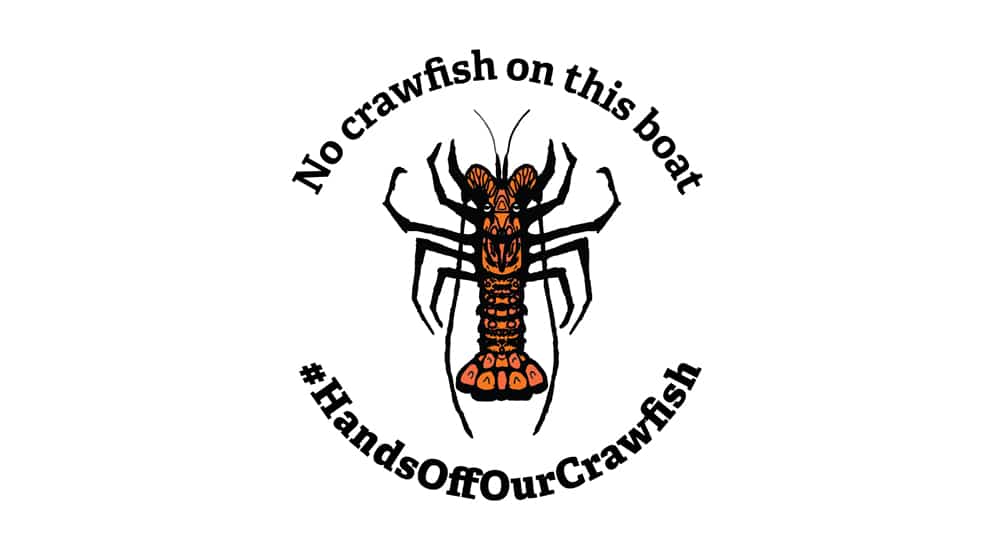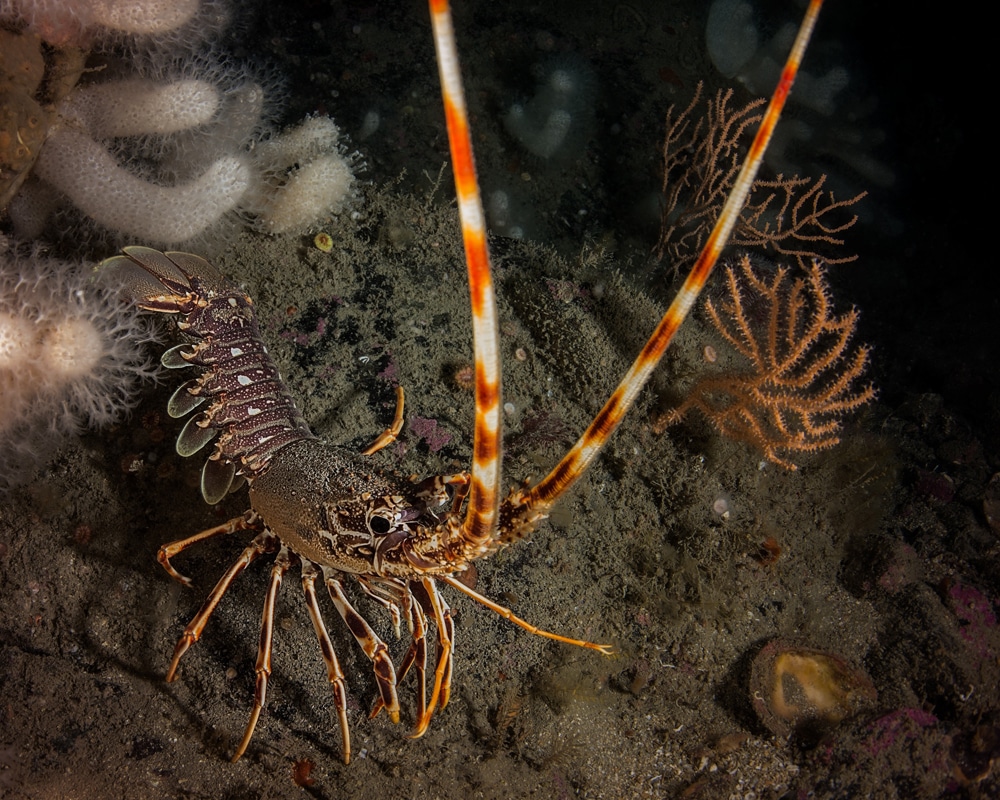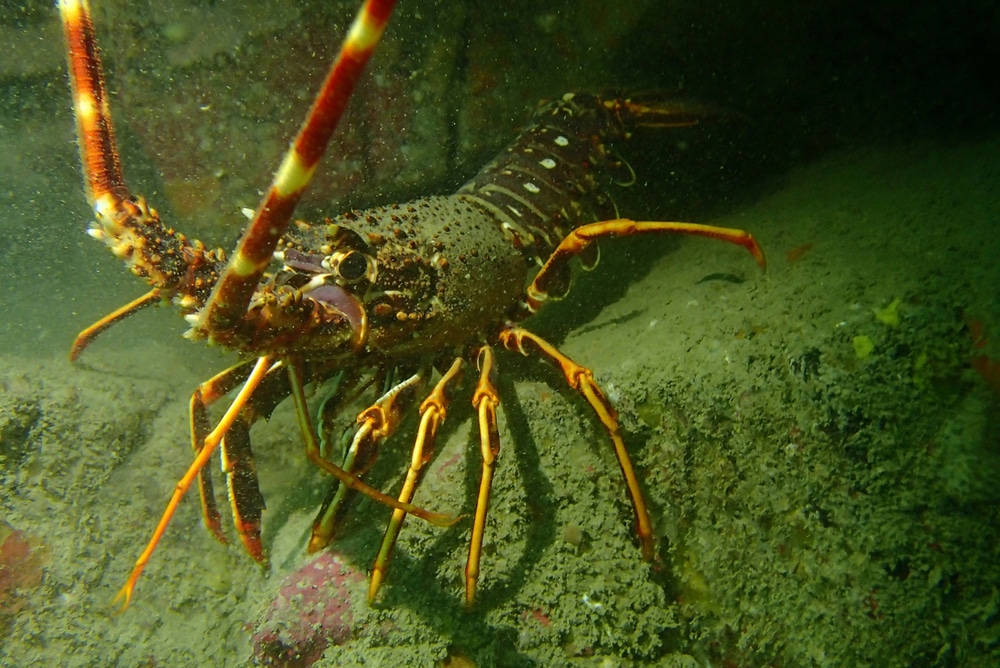Marine Life & Conservation Blogs
Divers asked to look after Cornwall’s Crawfish after dramatic comeback

A Cornwall Wildlife Trust initiative introduced by Jeff Goodman
I always thought it was OK to take one for the pot. Diving in the early seventies we hardly ever climbed out of the water without something for our tea. But as the eighties approached I saw less and less marine life as full ‘goody’ bags from divers got bigger and more frequent. I started to feel uneasy about what we were doing to our seas.
Of course commercial fishing and angling have always taken an horrendous toll on marine life but now we as divers were in a position to find and take what was left. There is no finer example to this than the wonderful Crawfish. Along with them the Lobsters and Scallops were equally depleted. Scallops reproduce far quicker than Crawfish and so had a better chance to recover. Lobsters were and are reintroduced by hatcheries in their hundreds of thousands. The Crawfish was ignored and left to simply vanish from the marine ecosystem.
Finally against all the odds, Crawfish are starting to re-appear in Cornish waters and already fishermen and divers are eager to take them.
I spoke with Matt Slater, Marine Awareness Officer for Cornwall Wildlife Trust and as a result he sent me the following article on their new initiative to give these incredible animals a fighting chance. Whether you live in Cornwall or Timbuktu, I urge, no implore you to read this and give it all the support you can.
Matt Slater:
After nearly forty years crawfish have made a dramatic comeback as large numbers of young crawfish have reappeared on wrecks and reefs all around the Cornish shores.
The crawfish or spiny lobster is a spiky and ornate relative of the common lobster, with incredible long antennae and a powerful finned tail. This species was overfished back in the 1970’s and 80’s by both fishermen and divers but in recent years marine conservationists have been thrilled to see their return.
However Cornwall Wildlife Trust is now calling on divers to show that they care about crawfish by pledging not to catch them through a new national campaign called #HandsOffOurCrawfish
They hope through education to get a high proportion of divers supporting this campaign with the eventual aim to see crawfish better protected in our waters, ensuring a sustainable fishery for the species. Dive schools, dive boats and dive clubs will be provided with stickers saying ‘no crawfish on this boat’ and the Trust hopes to provide a much needed clear message for the benefit of these creatures.
Crawfish can live to up to 60 years and are very slow growing. They have long antennae which are used to taste the water to help them look for food as they scavenge on the sea bed.
They also communicate by generating a strange creaking sound by rubbing the bases of their antennae against their shell. This sound can travel for long distances and may play a role in attracting mates.
Matt Slater, Marine Awareness officer for Cornwall Wildlife Trust describes his first encounter with these creatures:
“We dropped down to the seabed on a rocky reef off Newquay that I have dived many times over the years. Where previously I had never seen any crawfish, on this dive within just a few minutes we found 18 beautiful crawfish.”
“Through our Seasearch citizen science project our volunteer divers have recorded huge numbers of crawfish over the past few years in Cornish waters. And we now carry out repeat survey dives for this species at several locations in Cornwall.”
“Divers all around the south west are reporting crawfish at their favourite dive sites and everyone is really pleased to see them back. However, there is a strong concern from many that we must ensure that they are back for good and that fisheries for this species are carried out at sustainable levels to ensure that history does not repeat itself and they become over fished again.”
“The majority of recreational divers appreciate all the marine creatures they encounter and very few collect marine life to eat, preferring to enjoy peaceful encounters and underwater photography. Having said this, many popular dive sites appear to have groups of resident crawfish. If even small numbers of divers start collecting them, it would not take long for them to disappear once again.”
“We already have the support of many of Cornwall’s dive operators and dive schools but we would ask everyone to get involved and to pledge not to take crawfish on their dives – that’s why we started the ‘Hands Off Our Crawfish’ campaign.”
Dive Newquay were the first company to sign up to the campaign. Paddy Maher of Dive Newquay says, “Since we first set up our dive company five years ago we have always made our customers return any collected crawfish back into the sea. No one wants to see these creatures wiped out again as they were in the 1980’s. It makes absolute sense to educate divers and to ask people to think more about their impacts on the underwater world.”
To pledge please visit www.cornwallwildlifetrust.org.uk/crawfishproject Look out for the hash tag #HandsOffOurCrawfish on social media as the Trust hopes divers will share their photos and crawfish news to help spread the word about the project!
This campaign will also be promoted through the national Seasearch programme in Devon, Dorset and the Channel Islands.
Further information
Crawfish or spiny lobster
Palinurus elephas
- These ancient crustaceans are usually found on exposed rocky reefs at depths of at least fifteen meters.
- They are heavily armoured, with sharp spines for defence.
- Unlike lobsters crawfish don’t have large claws instead having spikey front legs.
- Crawfish grow slowly, and can grow to a maximum size of 1 meter living for at least 60 years.
- They take at least three years before they are old enough to breed. Larger females produce far more eggs than smaller ones.
- Crawfish use their spectacular, long antennae to taste tiny amounts of chemicals in water allowing them to detect predators and other mates as well as food.
- Crawfish can communicate using strange creaking sounds that they produce by rubbing the base of their long antennae against each other. This sound can travel for long distances underwater. Some Cornish fishermen actually call crawfish ‘creakers’
Seasearch
- Seasearch is a national citizen science project that trains recreational divers to record marine life and habitats they encounter on their dives.
- The project is led by the Marine Conservation Society and in Cornwall it is coordinated by and funded by Cornwall Wildlife Trust.
Aims of Seasearch
- To encourage the participation of volunteer recreational divers in marine conservation through gathering data, particularly for areas where little data exists or where there is a conservation need,
- To provide training in recording skills to enable volunteer recreational divers to participate in Seasearch,
- To make quality assured Seasearch data available to partner organisations and the general public,
- To raise public awareness of the diversity of marine life and habitats in Britain and Ireland through the dissemination of information gathered and the identification of issues arising from it.
Matt Slater, Marine Awareness Officer CWT
A Cornish Marine biologist and educator, experienced in aquarium and community engagement work. I am passionate about our marine world and love sharing this passion and encouraging us all to take better care for the oceans.
Blogs
The Ocean Cleanup Breaks 10,000,000 KG Barrier

The Ocean Cleanup, the global non-profit project, has removed a verified all-time total of ten million kilograms (22 million lbs.) of trash from oceans and rivers around the world – approximately the same weight as the Eiffel Tower.
To complete its mission of ridding the oceans of plastic, The Ocean Cleanup uses a dual strategy: cleaning up the Great Pacific Garbage Patch (GPGP) to remove the plastic already afloat in the oceans, while stopping the flow of plastic from the world’s most polluting rivers.
Through cleaning operations in the GPGP and in rivers in eight countries, the cumulative total of trash removed has now surpassed ten million kilograms. This milestone demonstrates the acceleration of The Ocean Cleanup’s impact, while underlining the astonishing scale of the plastic pollution problem and the need for continued support and action.
While encouraging for the mission, this milestone is only a staging point: millions more tons of plastic still pollute our oceans and The Ocean Cleanup intends to continue learning, improving and innovating to solve this global catastrophe.
This announcement comes as governments from around the world meet to continue negotiations to develop a new legally binding instrument to end plastic pollution at INC4 in Ottawa, Canada. Representatives of The Ocean Cleanup will be in attendance and the organization will be urging decision-makers to collaborate towards a comprehensive and ambitious global treaty which addresses plastic at all stages of its life cycle and in all marine environments worldwide, including in areas beyond national jurisdiction.
It is encouraging to see that the need for remediation is reflected in the various options for potential treaty provisions. It is essential that the final treaty contains clear targets for the remediation of legacy plastic pollution, and reduction of riverine plastic emissions.
Tackling plastic pollution requires innovative and impactful solutions. The treaty should therefore incentivize the innovation ecosystem by fostering innovations that make maximal use of data, technology and scientific knowledge – such as those designed and deployed by The Ocean Cleanup.
‘After many tough years of trial and error, it’s amazing to see our work is starting to pay off – and I am proud of the team who has brought us to this point.’ said Boyan Slat, Founder and CEO of The Ocean Cleanup. ‘While we still have a long way to go, our recent successes fill us with renewed confidence that the oceans can be cleaned.’
The Ocean Cleanup was founded in 2013 and captured its first plastic in 2019, with the first confirmed catch in the GPGP coming soon after the deployment of Interceptor 001 in Jakarta, Indonesia. After surpassing one million kilograms of trash removed in early 2022, the non-profit project has since progressed to the third iteration of its GPGP cleaning solution, known as System 03, and a network of Interceptors currently covering rivers in eight countries, with more deployments set for 2024.
About The Ocean Cleanup
The Ocean Cleanup is an international non-profit organization that develops and scales technologies to rid the world’s oceans of plastic. They aim to achieve this goal through a dual strategy: stemming the inflow via rivers and cleaning up the legacy plastic that has already accumulated in the ocean. For the latter, The Ocean Cleanup develops large-scale systems to efficiently concentrate the plastic for periodic removal. This plastic is tracked and traced through DNV’s chain of custody model to certify claims of origin when recycling it into new products. To curb the tide via rivers, The Ocean Cleanup has developed Interceptor™ solutions to halt and extract riverine plastic before it reaches the ocean. Founded in 2013 by Boyan Slat, The Ocean Cleanup now employs a broadly multi-disciplined team of approximately 140. The foundation is headquartered in Rotterdam, the Netherlands.
For more information, visit: theoceancleanup.com and follow @theoceancleanup on social media.
Marine Life & Conservation Blogs
Creature Feature: Dusky Shark

 In this series, the Shark Trust will be sharing amazing facts about different species of sharks and what you can do to help protect them.
In this series, the Shark Trust will be sharing amazing facts about different species of sharks and what you can do to help protect them.
This month we’re taking a look at the Dusky Shark, a highly migratory species with a particularly slow growth rate and late age at maturity.
Dusky sharks are one of the largest species within the Carcharhinus genus, generally measuring 3 metres total length but able to reach up to 4.2 metres. They are grey to grey-brown on their dorsal side and their fins usually have dusky margins, with the darkest tips on the caudal fin.
Dusky Sharks can often be confused with other species of the Carcharhinus genus, particularly the Galapagos Shark (Carcharhinus galapagensis). They have very similar external morphology, so it can be easier to ID to species level by taking location into account as the two species occupy very different ecological niches – Galapagos Sharks prefer offshore seamounts and islets, whilst duskies prefer continental margins.
Hybridisation:
A 2019 study found that Dusky Sharks are hybridising with Galapagos Sharks on the Eastern Tropical Pacific (Pazmiño et al., 2019). Hybridisation is when an animal breeds with an individual of another species to produce offspring (a hybrid). Hybrids are often infertile, but this study found that the hybrids were able to produce second generation hybrids!
Long distance swimmers:
Dusky sharks are highly mobile species, undertaking long migrations to stay in warm waters throughout the winter. In the Northern Hemisphere, they head towards the poles in the summer and return southwards towards the equator in winter. The longest distance recorded was 2000 nautical miles!
Very slow to mature and reproduce:
The Dusky Shark are both targeted and caught as bycatch globally. We already know that elasmobranchs are inherently slow reproducers which means that they are heavily impacted by overfishing; it takes them so long to recover that they cannot keep up with the rate at which they are being fished. Dusky Sharks are particularly slow to reproduce – females are only ready to start breeding at roughly 20 years old, their gestation periods can last up to 22 months, and they only give birth every two to three years. This makes duskies one of the most vulnerable of all shark species.
The Dusky Shark is now listed on Appendix II of the Convention on the Conservation of Migratory Species (CMS), but further action is required to protect this important species.
Scientific Name: Carcharhinus obscurus
Family: Carcharhinidae
Maximum Size: 420cm (Total Length)
Diet: Bony fishes, cephalopods, can also eat crustaceans, and small sharks, skates and rays
Distribution: Patchy distribution in tropical and warm temperate seas; Atlantic, Indo-Pacific and Mediterranean.
Habitat: Ranges from inshore waters out to the edge of the continental shelf.
Conservation status: Endangered.
For more great shark information and conservation visit the Shark Trust Website
Images: Andy Murch
Diana A. Pazmiño, Lynne van Herderden, Colin A. Simpfendorfer, Claudia Junge, Stephen C. Donnellan, E. Mauricio Hoyos-Padilla, Clinton A.J. Duffy, Charlie Huveneers, Bronwyn M. Gillanders, Paul A. Butcher, Gregory E. Maes. (2019). Introgressive hybridisation between two widespread sharks in the east Pacific region, Molecular Phylogenetics and Evolution 136(119-127), https://doi.org/10.1016/j.ympev.2019.04.013.
-

 News3 months ago
News3 months agoCapturing Critters in Lembeh Underwater Photography Workshop 2024: Event Roundup
-

 Marine Life & Conservation Blogs3 months ago
Marine Life & Conservation Blogs3 months agoCreature Feature: Swell Sharks
-

 Blogs2 months ago
Blogs2 months agoMurex Resorts: Passport to Paradise!
-

 Blogs2 months ago
Blogs2 months agoDiver Discovering Whale Skeletons Beneath Ice Judged World’s Best Underwater Photograph
-

 Gear Reviews3 weeks ago
Gear Reviews3 weeks agoGEAR REVIEW – Revolutionising Diving Comfort: The Sharkskin T2 Chillproof Suit
-

 Gear Reviews3 months ago
Gear Reviews3 months agoGear Review: Oceanic+ Dive Housing for iPhone
-

 News2 months ago
News2 months agoPADI Teams Up with Wellness Brand Neuro to Drive Ocean Change and Create a Blue State of Mind
-

 Marine Life & Conservation2 months ago
Marine Life & Conservation2 months agoSave the Manatee Club launches brand new webcams at Silver Springs State Park, Florida






















